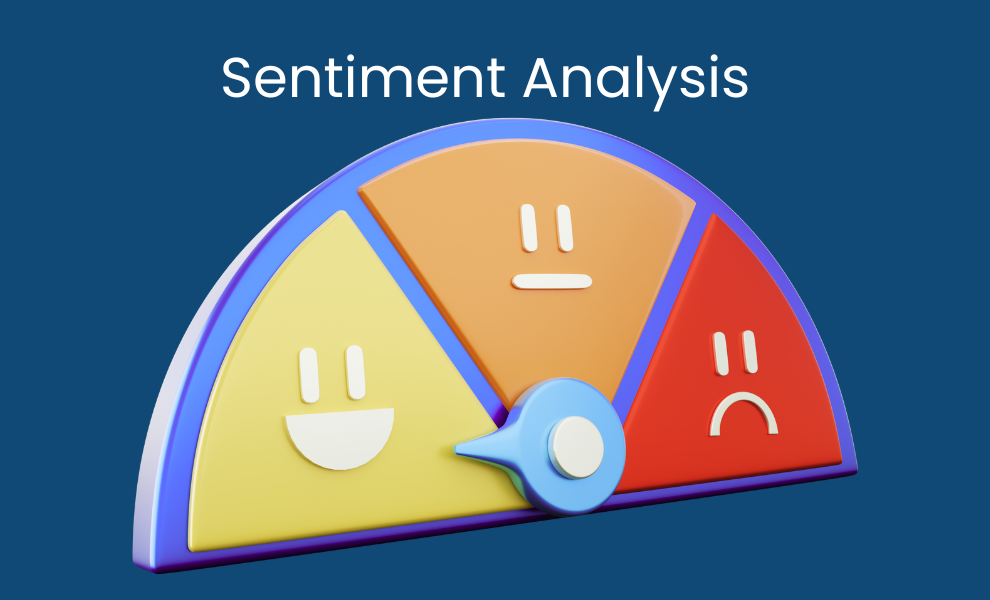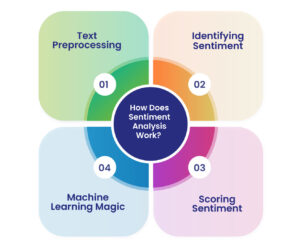Have you ever wondered how businesses are aware of what individuals think about their brands? Or how social media sites identify hate speech? The reason is sentiment analysis or opinion mining. It is an interesting component of Natural Language Processing (NLP) that enables machines to read human sentiment. Let’s understand it in easy terms and go through how it works, why it is beneficial, and where it is used.
What is Sentiment Analysis?
Sentiment analysis is similar to educating a computer to read between the lines. It is a method that assists machines in determining if a bit of text is positive, negative, or neutral. For instance, if a person tweets, “I love this new phone!” the system knows it is a positive comment. But if they tweet, “This phone is a disaster,” it identifies the negativity.
Think of it as a mood meter for text. It is not about words, but it is about the sense of the emotions behind them. As per sources, in 2025, it is expected that 87% of companies will use sentiment analysis to understand customer feelings from conversations, reviews, and other text.
Why is Sentiment Analysis Important?
Opinion mining surrounds you, even if you don’t realize it. Here’s why it matters so much:
- Business Insights: Businesses apply it to know what customers are saying. If customers are unhappy, they can correct things in seconds.
- Social Media Monitoring: It allows monitoring of what people are saying about brands, politicians, or events.
- Customer Support: Chatbots utilize opinion mining to reply accordingly, whether a customer is unhappy or pleased.
- Market Research: It assists companies to identify trends and learn what individuals need.
Opinion mining allows us to interpret the large volume of text data we create on a daily basis.
How Does Sentiment Analysis Work?
Opinion mining applies a combination of rules, algorithms, and machine learning. It works as follows:
1. Text Preprocessing
Prior to analysis, the system pre-cleans the text. It eliminates words that are not necessary (such as “and,” “the”) and splits sentences into smaller chunks. This is done to make the analysis accurate.
2. Identifying Sentiment
The system searches for words that are emotive. For instance, “happy,” “angry,” or “boring.” It also analyzes the context. For instance, “not happy” is negative, although “happy” is a positive word.
3. Scoring Sentiment
Each phrase or word receives a score. Positive phrases receive a +1, negative phrases receive a -1, and neutral phrases receive a 0. The system tallies these scores to arrive at the overall sentiment.
4. Machine Learning Magic
Smart systems use machine learning for better accuracy. They learn from historical data so that they know more about slang, sarcasm, and hard sentences.
Sentiment Analysis Types
Opinion mining is not a one-size-fits-all solution. According to the requirement, it is performed in the following ways:
- Polarity Detection: This is the basic version. It checks whether the text is positive, negative, or neutral.
- Emotion Detection: It is a deeper analysis for detecting particular emotions such as happiness, anger, or sorrow.
- Aspect-Based Analysis: It is concentrated on certain portions of a piece of text. For instance, a restaurant review can distinguish between food, service, and atmosphere comments.
- Intent Analysis: It identifies the purpose behind the text. Is the person or user complaining, suggesting something, or simply just sharing an opinion?
Challenges in Sentiment Analysis
Sentiment analysis is mighty, but it’s not flawless. These are some of the challenges:
- Sarcasm and Irony: Phrases such as “Great, another delay!” may mislead the system.
- Context Matters: The same word can have varying meanings depending on context. For instance, “sick” can be ill or cool, depending on the context.
- Multilingual Text: Processing text in more than one language makes it more complicated.
In spite of all these issues, opinion mining continues to improve with improved algorithms and greater data.
Real-Life Applications of Opinion Mining
Opinion mining is not only a technology buzzword but also it is being applied in real life in countless ways:
- E-commerce: Sites such as Amazon employ it to examine product feedback and enhance recommendations.
- Politics: Campaigns utilize it to assess public sentiment and customize their message.
- Healthcare: It is used to examine patient feedback in order to enhance services.
- Entertainment: Streaming services employ it to comprehend viewer response to programs and films.
The Future of Sentiment Analysis
As technology continues to improve, opinion mining will get even smarter. Just imagine a world where your phone can detect your mood from your texts and respond accordingly. Or where companies can forecast trends before they occur. The possibilities are limitless!
Wrapping Up!
Opinion mining is a game-changer in the world of NLP. It helps us understand emotions in text, making it easier for businesses, governments, and individuals to make better decisions. While it’s not perfect, it’s constantly evolving and improving.
So, the next time you leave a review or tweet about your favorite product, remember there is a good chance opinion mining is working behind the scenes to understand how you feel.
Explore more about Machine Learning and NLP Techniques on HiTechNectar!
FAQ
Q1. What is sentiment analysis in NLP techniques?
Answer: Opinion mining is a method to check whether the input text is positive, negative, or neutral. It understands the mood or feeling behind the words given by the user.
Q2. Can ChatGPT perform opinion mining?
Answer: Yes, ChatGPT helps to analyze the sentiment of text by checking whether the content is positive, negative, or neutral.
Q3. Which tool is used in doing opinion mining?
Answer: Tools used for opinion mining are TextBlob, VADER, and Google’s Natural Language API. These tools help to understand the emotions in the text.
You May Also Like to Read:
Effective Strategies to Combat the Curse of Dimensional Data Analysis



